Dr Charles john sells
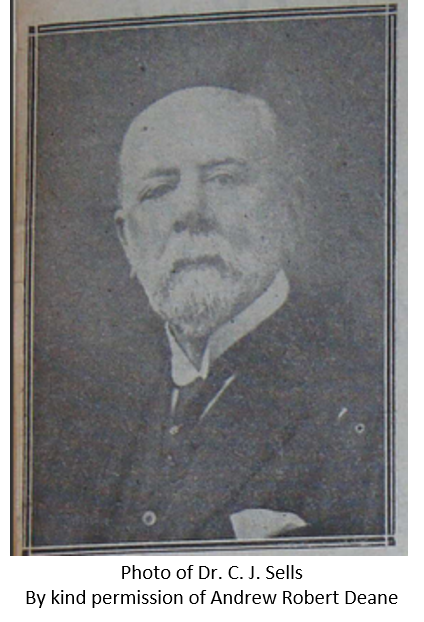
Subject Name: Doctor Charles John Sells (b 1876 – d 1923)
Researcher: Val Pink
GUILDFORD UNION MEDICAL OFFICER 1876 – 1923
Workhouse Doctor for 46 years, a much respected and liked man
Charles John Sells was the son of a doctor, following him into the medical profession and by the age of 23, had become a GP in his father’s practice at their Guildford home. Charles, after taking on an additional role at the Surrey County Hospital, took on a third when he was elected as Guildford Union Workhouse Medical Officer in 1876.
Despite ‘retiring’ once, he was to remain with the Guildford Union until 1922 during which time he had also been a Vaccination Officer and Justice of the Peace. It was still another year before he retired aged 76 from his first role as a Guildford GP, having served the community for 54 years. One Board of Guardians member said of Charles: ‘a more kind or more sympathetic man never lived’.
Charles and his first wife Emily had 12 children, with four of their sons also training as doctors, one of whom was involved in pioneering but ultimately fatal work with X-rays.
Growing up
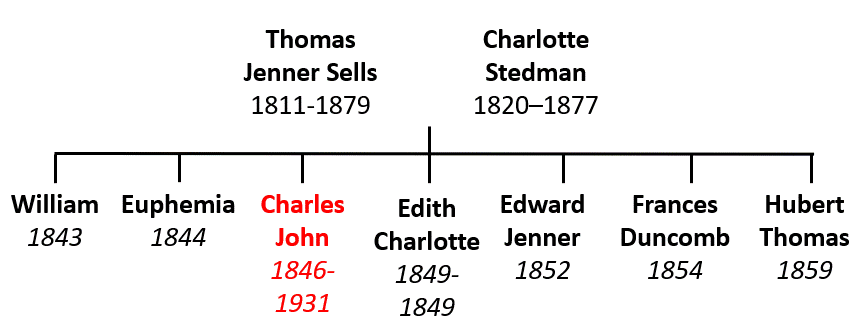 Charles John Sells was the third child of Surgeon and GP Thomas Jenner Sells and Charlotte née Stedman. He was baptised at St Mary’s Church in Guildford, on 12th August 1846 1, 2.
Charles John Sells was the third child of Surgeon and GP Thomas Jenner Sells and Charlotte née Stedman. He was baptised at St Mary’s Church in Guildford, on 12th August 1846 1, 2.
In 1851 Charles was living at 109 High Street, Guildford, with his parents, brother William, sister Euphemia, and 4 servants 3. A younger sister, Edith, had passed away aged 6 weeks in 1849 4. Also listed there was a 20-year-old ‘apprentice’ to Charles’ father.
Ten years on, 14-year-old Charles was a pupil at the Royal Grammar School, Guildford, just a short walk from home 5. Charles now had two more brothers, Edward and Hubert, plus a sister Frances. To help manage the household there was a cook, housemaid, family nurse and nursemaid. Charles’ father remained a Surgeon GP, with a live-in ‘medical assistant’. Dr Sells senior, it would appear, was teaching those wishing to join the medical profession.
Charles qualifies as a doctor and becomes a GP in Guildford
After leaving school, Charles undertook medical training. Like his father, he studied at Guy’s Hospital, London, and then in Paris 6.
Medical training at this time was not well organised. It was expensive, costing £500 to £1000 in fees, board and lodging, and the success rate was low 7. Despite this, at the young age of 21, the local press in 1867 reported that ‘Charles John Sells and Reginald Eager, the sons of two of our most respected Medical Practitioners in Guildford, have successfully passed their examination in the science and practice of medicine and received certificates to practice’ 8.
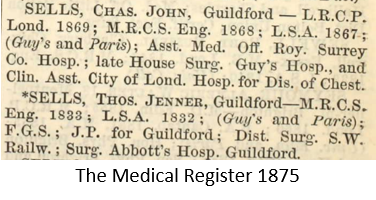 After qualifying as a Licentiate of the Society of Apothecaries (LSA) in 1867, Charles went on to become a Member of the Royal College of Surgeons (MRCS) in 1868, and to gain a Licentiate of the Royal College of Physicians (LRCP) in 1869.
After qualifying as a Licentiate of the Society of Apothecaries (LSA) in 1867, Charles went on to become a Member of the Royal College of Surgeons (MRCS) in 1868, and to gain a Licentiate of the Royal College of Physicians (LRCP) in 1869.
Charles joined his father’s private medical practice as a General Practitioner (GP), based at the family home in High Street, Guildford 9. Living with them in April 1871 were Charles’ mother Charlotte, younger sister Frances, two servants, and an ‘assistant in surgery’. Charles’ father was now not only a GP, but also a Justice of the Peace and an Alderman of Guildford.
Somewhat controversially appointed Honorary Medical Officer at the Royal Surrey Hospital
In February  1871, Charles had offered himself as a candidate for the post of Honorary Assistant Medical Officer to the Royal Surrey County Hospital via a letter in the public notices of the local paper 10. On the same page was a letter from another hopeful candidate, Henry Holland.
1871, Charles had offered himself as a candidate for the post of Honorary Assistant Medical Officer to the Royal Surrey County Hospital via a letter in the public notices of the local paper 10. On the same page was a letter from another hopeful candidate, Henry Holland.
A meeting of the Hospital Governors on 27th April concluded that local man Charles was the best candidate. He had many supporters, including Mr Alchin, a Guildford Union Guardian responsible for part of Charles’ medical district. Mr Alchin pointed out that Charles had not only joined his father’s extensive practice but was also his father’s substitute as Medical Officer for Worplesdon, one of the largest districts of the Guildford Union 11. Mr Alchin found Charles to be ‘most kind in his manners, most attentive to their requirements, and most skilful in operations’. He continued: ‘his numerous qualifications may be summed up as consisting of great amiability, combined with high medical talent’.
Despite the support for Charles, it was decided that an official poll should be held. Three weeks later, on 18th May at the Surrey County Hospital, Charles was announced as their Honorary Assistant Medical Officer, winning by 242 votes to 60 12.
Charles thanked his supporters in an open letter published in the 20th May edition of the West Surrey Times 13. Above his letter was one from Henry Holland, also thanking those who had backed him, but having been unsuccessful, said he would be writing again about the election ‘due to much local interest being brought to bear against me’. This he did the following week. In a long letter to the editor, Henry stated that he felt the ‘present corrupt system of friendly canvassing’ meant that no outside candidate ‘can have a chance of success’ 14.
Guildford Union House Surgeon
Five years after his appointment to the Royal Surrey County Hospital, in 1876 Charles applied for the position of ‘House Surgeon’ to the Guildford Union, basically Doctor to the Workhouse and its infirmary 15. He was appointed by 14 votes to 6, at a salary of £15 per annum. One of Charles’ supporters on the Board of Guardians said of Charles: ‘he knew from experience a more kind or more sympathetic man never lived’.
The role of the Workhouse Medical Officer was to ‘attend duly and punctually upon all poor persons in the Workhouse requiring medical attendance, and according to his agreement to supply the requisite medicines to such persons’ 16. He would be at the Workhouse at specified times and when sent for by the Master or Matron. His many jobs included examining paupers and vagrants on admission, overseeing the diet of the sick (for example advising if extra meat, beer or porter was needed), advising on ‘lunatic’ paupers, reporting maintenance issues that may affect the health of inmates, recording the cause of workhouse deaths.
At this time, there were few who could afford to see a doctor. Free health care for all was not available until 1948 with the formation of the National Health Service. Some subscribed to Friendly Societies which provided financial help in times of sickness or injury, but the poorest had to rely on medical help from their local Poor Law Union 17, 18.
Charles also regularly attended County Court sessions and Coroner inquiries to give medical evidence regarding accidents, fights, suspicious deaths and so on 19.
With all these duties to perform, Charles needed good, reliable transportation. He placed advertisements in the local press for a coachman and an experienced stable boy so that he could be driven around Guildford, Worplesdon and the surrounding villages 20.
District Medical Officer for Worplesdon and Pirbright
After his father’s death in April 1879, Charles went into partnership at his Guildford High Street home and practice with Dr Francis Rutherford Russell 21, 22. Charles also took over from his father  the role of District Medical Officer and Public Vaccination Officer for the ‘Worplesdon District… there being no medical man resident in the District and as Guildford is the nearest place and easily accessible’ 23, 24. His pay was £60 per annum as District Medical Officer, plus 15 shillings (£0.75) for midwifery cases.
the role of District Medical Officer and Public Vaccination Officer for the ‘Worplesdon District… there being no medical man resident in the District and as Guildford is the nearest place and easily accessible’ 23, 24. His pay was £60 per annum as District Medical Officer, plus 15 shillings (£0.75) for midwifery cases.
The duties in Charles’ new role were similar to, and in addition to his Workhouse responsibilities, that is to ‘attend duly and punctually upon all poor persons requiring medical attendance within the District of the Union assigned to him, and according to his agreement to supply the requisite medicines to such persons’. He would see the pauper sick either in their homes or at his surgery, working closely with the local Relieving Officer HYPERLINK TO HENRY PORTSMOUTH, between them completing all the necessary paperwork for the Union. Charles was also responsible for visiting pauper ‘lunatics’ resident in his district at least once every three months 25.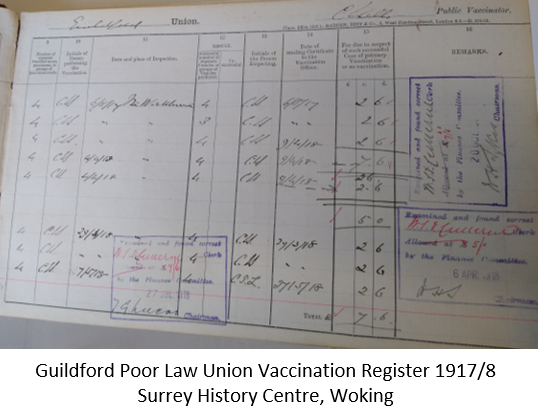
As District Vaccination Officer, Charles was also responsible for giving children their compulsory smallpox vaccinations 26.
Changes to the District Medical Officer Role
Until 1881 the eight Guildford Union Medical Officers, including Charles, were also carrying out the role of public Medical Officers of Health, mostly concerned with local sanitation issues affecting health 27. As the Medical Officers were all also in private practice, the Guildford Rural Sanitary Authority recognised that this could lead to a clash of interests – for example, if a public health issue arose in a cottage belonging to a landlord who was a private patient of the Medical Officer of Health. The Sanitary Authority therefore decided to appoint just one Medical Officer for Health, not in private practice, to cover the whole Guildford district. Charles therefore lost this part of his role, and the corresponding part of his District Medical Officer salary – £10 per year plus 10 shillings 6d (£0.52½) per visit to a ‘nuisance’ 28.
Charles’ workload for the Guildford Poor Law Union was reduced again in July 1889, when the Worplesdon and Pirbright District was divided into two. Charles kept the Worplesdon area, on a salary of £40 per annum, while the newly formed Pirbright district was advertised at a salary of £20 29. He stayed as Vaccination Officer for both Districts 30.
Justice of the Peace
In May 1887, Charles was proposed as a Justice of the Peace. Some concern was raised at the Town Council as to whether Charles would have the time to devote to magisterial duties on top of his workload as a private GP, Honorary Medical Officer at the County Hospital, Guildford Union House Surgeon and Medical Officer for Worplesdon and Pirbright District. Councillor Walbrook replied that ‘Mr Sells’ father was a doctor, and he was very attentive in the discharge of his magisterial duties’. Reassured, Charles was duly appointed as a Justice of the Peace 31.
Charles himself was not above the law, though, as he was fined 5 shillings (£0.25) in 1898 for allowing his dogs to run unmuzzled 32.
Marriage brought a time of both joy and sadness for Charles
Charles had married Rochdale-born Emily Schofield on 16th April 1873 in Grantham, Lincolnshire, where Emily’s parents were living at the time 33, 34, 35. How they met is not known but Emily was educated at Park Lodge in Clapham, not far from London and Guildford, so they could have met at a function or through friends 36.
The couple continued to live at Charles’ childhood home where his practice was based. They soon started what was to become a large family 37.
The 1881 Census recorded the family occupying numbers 109 and 110 High Street 38.  With seven children under the age of 8 at home, plus Emily’s mother and sister, and 7 servants including a cook and a nursemaid, it’s no wonder that he needed extra room!
With seven children under the age of 8 at home, plus Emily’s mother and sister, and 7 servants including a cook and a nursemaid, it’s no wonder that he needed extra room!
Four more children followed, making a total of 12, three of whom died in early childhood 39.
A move from High Street to Spital Street
In the early 1880s, the family moved a very short distance to White Lodge (later known as White Hall), Spital Street 40, 41. Spital Street at this time was a continuation of Guildford High Street, which became Upper High Street in 1901. The name Spital was an abbreviation of Hospital Street which referred to the Leper Hospital that had stood at the junction of Epsom and London Road until the 1840s 42.
By 1891, Charles and Emily were employing 5 live-in staff – a governess, butler, footman, cook and housemaid to help with the six children still at home – Violet, Bertram, Sybil, Hugh, Archibald and Reginald 43.
Charles’ wife Emily and two sons pass away
In January 1897, Charles’ wife Emily died of pneumonia, following influenza, aged 50 44. On announcing the death, a local newspaper recognised the regard in which she and the family were held: ‘Great sympathy is felt for Mr. Sells and the family, who are highly esteemed’.
Charles remained in his White Hall residence, recorded there on the 1901 Census with his daughters Violet (27) and Sybil (20) who were both artists, living off their own means 45. Charles’ previous home and practice at 109 High Street was still occupied by his partner Dr Francis Russell 46.
 Charles lost two more children at the turn of the century. His oldest son Charles Bernard, who had followed him into the medical profession, had started training as a doctor at Guy’s Hospital in London. However, he had interrupted his studies to fight in the second Boer War in South Africa, joining the medical team at the Imperial Yeomanry Hospital, Deelfontein. In January 1901, he died from enteric fever (typhoid) aged 26 47.
Charles lost two more children at the turn of the century. His oldest son Charles Bernard, who had followed him into the medical profession, had started training as a doctor at Guy’s Hospital in London. However, he had interrupted his studies to fight in the second Boer War in South Africa, joining the medical team at the Imperial Yeomanry Hospital, Deelfontein. In January 1901, he died from enteric fever (typhoid) aged 26 47.
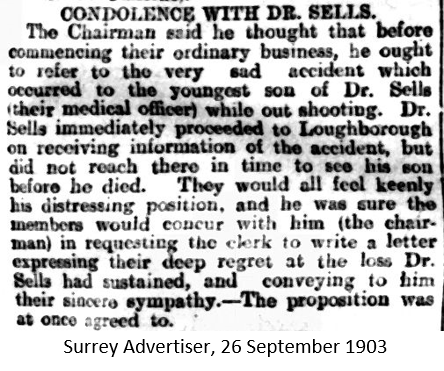 Then in September 1903, Charles’ youngest son Reginald Wilfred died aged 19 in a shooting accident in Stamford on Soar, Nottinghamshire, where he was a student and member of the Volunteer Corps at the Electrical Works 48. Reginald had shot and injured a hare, ran after it and struck it with the butt of his gun which caused the second barrel to discharge, fatally wounding him.
Then in September 1903, Charles’ youngest son Reginald Wilfred died aged 19 in a shooting accident in Stamford on Soar, Nottinghamshire, where he was a student and member of the Volunteer Corps at the Electrical Works 48. Reginald had shot and injured a hare, ran after it and struck it with the butt of his gun which caused the second barrel to discharge, fatally wounding him.
Widower Charles re-marries, moves to Epsom Road
In June 1904, Charles re-married in Cranford, Middlesex, to Edith Willoughby Darvell, some 27 years his junior 49, 50. Edith was born in Rossett, Denbighshire, Wales, the daughter of a clergyman. The marriage was reported at length in Middlesex newspapers as ‘Fashionable wedding at Cranford’, describing what was worn, who was there, and what gifts had been given and by whom.
Charles continued working at his own medical practice, the Royal Surrey Hospital, and for the Guildford Union at the Workhouse and in the Worplesdon district.
 His medical partner of almost 30 years, Dr Francis Russell, died in 1908, after which Charles’ went into partnership with Dr Cecil Lankester 51, 52. Shortly after this, Charles and wife Edith moved home to Four Paths, Epsom Road, Guildford, while his practice with Dr Lankester was at 54 Quarry Street.
His medical partner of almost 30 years, Dr Francis Russell, died in 1908, after which Charles’ went into partnership with Dr Cecil Lankester 51, 52. Shortly after this, Charles and wife Edith moved home to Four Paths, Epsom Road, Guildford, while his practice with Dr Lankester was at 54 Quarry Street.
Resigns – then re-signs
The Great War broke out in August 1914, and by early 1916, the Guildford Union Infirmary was to be requisitioned by the Army as a hospital for soldiers 53. This meant Charles’ position as Medical Officer was under threat, as was his salary and pension. Charles was now 70, so in March 1916, after 40 years with the Union, he regretfully handed in his resignation but said that his ‘services would be at their disposal at any time’ until a successor was appointed 54.
However, this was not to be the end for Charles, as the Guildford Union Board agreed to pay him a reduced salary of £50 per annum (£90 plus fees in 1904) and to give him an extra allowance to compensate for the pension contribution he would lose for remaining as their Medical Officer on a lower salary. Upon hearing this, Charles agreed to withdraw his resignation 55, 56, 57.
Another family loss
Charles lost a third son, Archibald, who was shot and killed by a German sniper in September 1916 aged 33 whilst taking observations of enemy lines in Flanders, Belgium 58. Archibald had been serving with the Queens Royal West Surrey Regiment and had only recently returned to the frontline after being wounded in both legs five months earlier. He left behind wife Mona, a son and a daughter.
Charles and Edith leave Guildford
After the First World War had ended in November 1918, life gradually returned to normal at the Workhouse, now renamed the Guildford Institution. Charles was still their Medical Officer and running his practice from his Four Paths home in Epsom Road 59, 60.
 By the summer of 1922, Charles was 76 and decided, for the second and final time, to resign from his post as Medical Officer for the Guildford Union, having been in the role for 46 years 61. The Guildford Institution presented Charles with a dinner service and six antique cut glass tumblers for his services, while the Chairman of the Board, Mr Charles H Bessant, wrote to Charles saying: ‘We all greatly regret that the time has come when you have found it necessary to retire from the post of Medical Officer of the Institution, and we feel that we and all those under your care have lost a great friend’ 62.
By the summer of 1922, Charles was 76 and decided, for the second and final time, to resign from his post as Medical Officer for the Guildford Union, having been in the role for 46 years 61. The Guildford Institution presented Charles with a dinner service and six antique cut glass tumblers for his services, while the Chairman of the Board, Mr Charles H Bessant, wrote to Charles saying: ‘We all greatly regret that the time has come when you have found it necessary to retire from the post of Medical Officer of the Institution, and we feel that we and all those under your care have lost a great friend’ 62.
It was another year, however, before Charles sold his practice and left his Four Paths home 63. He had served Guildford as a GP since 1869, a total of 54 years.
Charles and his wife Edith moved from Guildford in September 1923 to Llandrindod Wells in mid-Wales 64. Charles joined the local Angling Society, as one of his hobbies was fishing, motoring being his other pleasure. Edith’s hobby was golf, becoming the Honorary Secretary for Llandrindod Wells Ladies’ Golf Club.
Charles died in Llandrindod Wells in September 1931 at the age of 85 after some months of failing health 65. Edith passed away there in January 1934 at the age of 60 66.
August 2024, updated October 2025
Edited by Mike Brock
With many thanks to Andrew Robert Deane for permission to use his family photograph of
Dr. C. J. Sells.
You can read more about the Charles Sells’ family here: What did his surviving children do
We’d love to hear from you if you are a relative of the Sells family.
Please contact us by email: spikelives@charlotteville.co.uk
 Spike Lives is a Heritage project that chronicles the lives of inmates, staff and the Board of Guardians of the Guildford Union Workhouse at the time of the 1881 Census. The Spike Heritage Museum in Guildford offers guided tours which present a unique opportunity to discover what life was like in the Casual/Vagrant ward of a Workhouse. More information can be found here
Spike Lives is a Heritage project that chronicles the lives of inmates, staff and the Board of Guardians of the Guildford Union Workhouse at the time of the 1881 Census. The Spike Heritage Museum in Guildford offers guided tours which present a unique opportunity to discover what life was like in the Casual/Vagrant ward of a Workhouse. More information can be found here
Sources and References
The primary source of information was the Guildford Union Board of Guardians Minute Books, held at the Surrey History Centre, Woking, which also holds Surrey newspapers, parish and other local records.
Board of Guardian meetings were also reported extensively in the newspapers of the day, available at Surrey History Centre and online through the British Newspaper Archive.
Most records can also be found online at Ancestry.co.uk, FindMyPast.co.uk and other genealogy companies. Other sources are detailed in the numbered references. A complete list is here: Charles John Sells references
